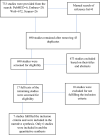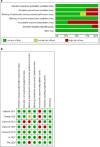Effects and safety of vagus nerve stimulation on upper limb function in patients with stroke: a systematic review and meta-analysis
- PMID: 37723225
- PMCID: PMC10507009
- DOI: 10.1038/s41598-023-42077-2
Effects and safety of vagus nerve stimulation on upper limb function in patients with stroke: a systematic review and meta-analysis
Abstract
Vagus nerve stimulation (VNS) is used to deliver electric current to stimulate the vagus nerve. The aim of this study is to carry out a systematic review and meta-analysis to determine its effects on motor function in patients with stroke. PubMED, Embase, Web of Science (WoS), and Scopus were searched. Data on time since stroke, and mean scores and standard deviation on outcomes such as level of impairment and motor function were extracted. The results showed that invasive (MD 2.66, 95% CI 1.19-4.13, P = 0.0004) and non-invasive (MD 24.16, 95% CI 23.56-24.75, P = 0.00001) VNS are superior at improving level of motor impairment than the control post intervention and at follow-up respectively. Similarly, VNS improved motor function post intervention (MD 0.28, 95% CI 0.15-0.41, P < 0.0001); and there was no significant difference in adverse events between invasive VNS and control (OR 2.15, 95% CI 0.97-4.74, P = 0.06), and between non-invasive VNS and control (OR 4.54, 95% CI 0.48-42.97, P = 0.19). VNS can be used to improve motor function in patients with stroke.
© 2023. Springer Nature Limited.
Conflict of interest statement
The authors declare no competing interests.
Figures



Similar articles
-
Application of vagus nerve stimulation on the rehabilitation of upper limb dysfunction after stroke: a systematic review and meta-analysis.Front Neurol. 2023 Jun 21;14:1189034. doi: 10.3389/fneur.2023.1189034. eCollection 2023. Front Neurol. 2023. PMID: 37416314 Free PMC article.
-
Vagus nerve stimulation for upper limb motor impairment after ischemic stroke: A meta-analysis.Medicine (Baltimore). 2021 Nov 19;100(46):e27871. doi: 10.1097/MD.0000000000027871. Medicine (Baltimore). 2021. PMID: 34797327 Free PMC article.
-
Efficacy and Safety of Vagus Nerve Stimulation in Stroke Rehabilitation: A Systematic Review and Meta-Analysis.Cerebrovasc Dis. 2023;52(3):239-250. doi: 10.1159/000526470. Epub 2022 Sep 27. Cerebrovasc Dis. 2023. PMID: 36167034
-
Efficacy and safety of vagus nerve stimulation on upper extremity motor function in patients with stroke: A meta-analysis of randomized controlled trials.NeuroRehabilitation. 2023;53(3):253-267. doi: 10.3233/NRE-230106. NeuroRehabilitation. 2023. PMID: 37694313 Review.
-
Effect of vagus nerve stimulation paired with rehabilitation for upper limb function improvement after stroke: a systematic review and meta-analysis of randomized controlled trials.Int J Rehabil Res. 2022 Jun 1;45(2):99-108. doi: 10.1097/MRR.0000000000000509. Epub 2021 Nov 24. Int J Rehabil Res. 2022. PMID: 34839304 Free PMC article.
Cited by
-
Multifaceted support for caregivers of stroke patients to meet the dynamic needs of patients: A qualitative study.J Educ Health Promot. 2025 Feb 28;14:70. doi: 10.4103/jehp.jehp_1776_23. eCollection 2025. J Educ Health Promot. 2025. PMID: 40144151 Free PMC article.
-
Vagus nerve stimulation: innovative applications in the field of hand function rehabilitation.Cogn Neurodyn. 2025 Dec;19(1):98. doi: 10.1007/s11571-025-10284-4. Epub 2025 Jun 23. Cogn Neurodyn. 2025. PMID: 40568488 Review.
-
Mechanisms of Vagus Nerve Stimulation in Improving Motor Dysfunction After Stroke.Neuropsychiatr Dis Treat. 2024 Dec 21;20:2593-2601. doi: 10.2147/NDT.S492043. eCollection 2024. Neuropsychiatr Dis Treat. 2024. PMID: 39723115 Free PMC article. Review.
-
Research hotspots and frontiers of vagus nerve stimulation in stroke: a bibliometric analysis.Front Neurosci. 2024 Dec 11;18:1510658. doi: 10.3389/fnins.2024.1510658. eCollection 2024. Front Neurosci. 2024. PMID: 39723424 Free PMC article. Review.
References
Publication types
MeSH terms
LinkOut - more resources
Full Text Sources
Medical

